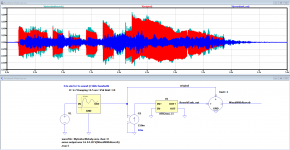Hi all
Since yesterday, a new milestone is set in the history of spice models.
I'm proud to introduce the world's first usable spice model for reverb tanks! 😀
After a bunch of impulse signal delay time measurements with a function generator and a scope on a sample of a TAD 8FB2 reverb tank, I was able to mimic the reverbs behaviour surprisingly well with spice's transmissionlines. The degree of reflection is managed by impedance steps from one transmissionline to the next or to a termination resistance.
Also the complexe impedance of the input and output coils is modeled, considering Rdc, inductance and parasitic capacitance.
After some experimental trials, I'm now able to push a 5s guitar track through my virtual reverb tank, and mix it with the original signal in half a minute of number crunching (with a Intel i7 2.9GHz CPU). Well, that's not super fast, but acceptable in my opinion.
However, if you are interested in the model or want to listen how the result sounds like, just visit my page:
http://adrianimmler.simplesite.com/448517750
Any feedback/proposal is welcome!
all the best, Adrian
Since yesterday, a new milestone is set in the history of spice models.
I'm proud to introduce the world's first usable spice model for reverb tanks! 😀
After a bunch of impulse signal delay time measurements with a function generator and a scope on a sample of a TAD 8FB2 reverb tank, I was able to mimic the reverbs behaviour surprisingly well with spice's transmissionlines. The degree of reflection is managed by impedance steps from one transmissionline to the next or to a termination resistance.
Also the complexe impedance of the input and output coils is modeled, considering Rdc, inductance and parasitic capacitance.
After some experimental trials, I'm now able to push a 5s guitar track through my virtual reverb tank, and mix it with the original signal in half a minute of number crunching (with a Intel i7 2.9GHz CPU). Well, that's not super fast, but acceptable in my opinion.
However, if you are interested in the model or want to listen how the result sounds like, just visit my page:
http://adrianimmler.simplesite.com/448517750
Any feedback/proposal is welcome!
all the best, Adrian
Attachments
Not only nice, but also a real help for typical questions popping up during reverb design, like:
"Which amount of reverb signal shall I mix to the original signal?"
or "what if I would shift the Input highpass frequency from 250Hz to 400Hz?"
"Which amount of reverb signal shall I mix to the original signal?"
or "what if I would shift the Input highpass frequency from 250Hz to 400Hz?"
After a bunch of impulse signal delay time measurements with a function generator and a scope on a sample of a TAD 8FB2 reverb tank, I was able to mimic the reverbs behaviour surprisingly well with spice's transmissionlines. The degree of reflection is managed by impedance steps from one transmissionline to the next or to a termination resistance.
That is because the reverb spring is a transmission line. See this oldie: AT&T Archives: Similiarities of Wave Behavior (Bonus Edition) - YouTube from 19:00 onwards.
....world's first usable spice model for reverb tanks! 😀 ....
Wow! 😱 😱 😱
But... why is this in "Tubes"? Do Hi-Fi-natics still run a Fisher Reverberation Unit in their listening room? (I know one who does, but she is 'special'.) Instruments And Amps?
@ Tom
Thanks for that hint - super interesting stuff. I enjoyed wachting this video!
It is is much better explained than in many lessons of today's school.
@zintolo
Thanks for your congratulations. I did a short look into my "stock" and discovered two other reverb tanks - so some more models will follow when I find time for the measurments. 😉
@PRR
well, I thought the only guys interested in that stuff are those building tube guitar amps...
But thank you for that hint, I will add a post at "Instrument and Amps"
all the best, Adrian
Thanks for that hint - super interesting stuff. I enjoyed wachting this video!
It is is much better explained than in many lessons of today's school.
@zintolo
Thanks for your congratulations. I did a short look into my "stock" and discovered two other reverb tanks - so some more models will follow when I find time for the measurments. 😉
@PRR
well, I thought the only guys interested in that stuff are those building tube guitar amps...
But thank you for that hint, I will add a post at "Instrument and Amps"
all the best, Adrian
Adrian,
Can you provide the equivalent circuit of the tank? Your model will not work with almost any other flavor of spice...
Les
Can you provide the equivalent circuit of the tank? Your model will not work with almost any other flavor of spice...
Les
It interesting but belongs to an other forum indeed... I see you have found it already..
https://www.diyaudio.com/forums/instruments-and-amps/
https://www.diyaudio.com/forums/instruments-and-amps/
However, if you are interested in the model or want to listen how the result sounds like, just visit my page:
http://adrianimmler.simplesite.com/448517750
Any feedback/proposal is welcome!
all the best, Adrian
Hey,
Thanks for your work.
I manage to create the ltspice model for your .cir file but the outpout stay at I and V = 0 with or without load.
Could you provide a minimal working exemple of your circuit ?
Thank you.
Hi TomHey,
Thanks for your work.
I manage to create the ltspice model for your .cir file but the outpout stay at I and V = 0 with or without load.
Could you provide a minimal working exemple of your circuit ?
Thank you.
Sorry for my late reply - I was OFF for the last 3 days. When you provide me an email address of you, I can send you a tested/working Schematics example (.asc file) containing my reverb spice model, ok?
BR Adrian
- Home
- Amplifiers
- Tubes / Valves
- breaking news: Spicemodel for reverb tanks!
